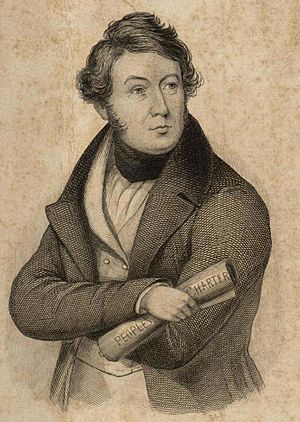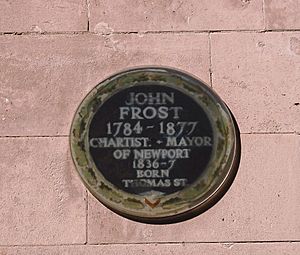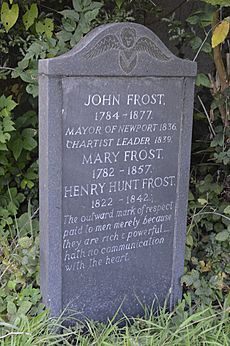John Frost (Chartist) facts for kids
Quick facts for kids
John Frost
|
|
|---|---|
 |
|
| Born | 25 May 1784 Newport, Monmouthshire, Wales
|
| Died | 27 July 1877 (aged 93) Stapleton, Bristol, England
|
| Resting place | Church of the Holy Trinity with St Edmund, Horfield, Bristol |
| Monuments | John Frost Square, Newport |
| Nationality | Welsh |
| Occupation | Tailor |
| Known for | Chartism |
| Criminal charge(s) | High treason |
| Criminal penalty | To be hanged, drawn and quartered; commuted to transportation for life |
| Criminal status | Unconditional pardon |
| Spouse(s) | Mary Geach |
John Frost (born May 25, 1784 – died July 27, 1877) was an important leader in the British Chartist movement. He played a key role in the Newport Rising, a major event in Welsh history.
Contents
John Frost's Early Life
John Frost was born in Newport, a town in Monmouthshire. His father, also named John, ran a local inn. John Frost was mostly raised by his grandfather, who was a bootmaker.
When he was 16, John left home to become a tailor and a draper's apprentice. He worked in Cardiff, Bristol, and London. In 1806, he returned to Newport and started his own successful business. He married Mary Geach in 1812, and they had eight children together. People thought highly of John Frost, describing him as "studious, quiet and obedient."
Becoming a Chartist Leader
In 1821, John Frost had a disagreement with a lawyer in Newport, Thomas Prothero. This led to legal troubles for Frost, and he was even sent to prison for six months. After his release, Frost became very critical of powerful people in Newport, like Sir Charles Morgan, a wealthy landowner. Frost believed that the voting system needed to change to make leaders more accountable.
In the early 1830s, Frost became a strong supporter of universal suffrage. This idea meant that all adult men, regardless of how much money they had, should be allowed to vote. This was a main goal of the Chartist movement.
In 1835, Frost was elected as a town councillor for Newport. He also became a magistrate, which is like a local judge. The next year, he became the Mayor of Newport. However, his strong opinions and his role in the Chartist movement upset his old enemies. He lost the mayoral election the next year, and the government took away his magistrate position.
A Letter to the Government
Because John Frost continued to be a leader in the Chartist movement, the Home Secretary (a top government official) removed him from his position as a justice of the peace. John Frost responded with a powerful letter while at a Chartist meeting. This letter included songs that showed the strong feelings of Welsh coal miners:
Uphold those bold Comrades, who suffer for you,
Who nobly stand foremost, demanding your due,
Away with the timid –'tis treason to fear–
To surrender or falter, when danger is near,
For now that our leaders disdain to betray
'Tis base to desert them, or succour delay
'Tis time that the victims of labour and care
Should for reap what is labour's fair share
'Tis time that these voice in the councils be heard
The rather than pay for the law of the sword;
All power is ours, with a will of our own
We conquer, united – divided we groan.
Come hail brothers, hail the shrill sound of the horn
For ages deep wrongs have been hopelessly borne
Despair shall no longer our spirits dismay
Nor wither the arms when upraised for the fray;
The conflict for freedom is gathering nigh:
We live to secure it, or gloriously die.
Even though many Welsh Chartists wanted to rebel, Frost himself wanted to wait. By late October, Welsh Chartists were holding daily meetings, pushing for an armed uprising. Frost tried to delay it, but eventually, he couldn't stop it. The date for the uprising was set for November 3.
The Newport Rising
On November 3–4, 1839, John Frost, along with William Jones and Zephaniah Williams, led a large Chartist march towards the Westgate Inn in Newport. The reasons for this direct confrontation are not fully clear. Some believe it was because Frost was unsure about the more violent Chartists, and he had personal issues with some of the Newport leaders who were inside the hotel.
The Chartist movement in south-east Wales was very active at this time. A key Chartist leader, Henry Vincent, had been arrested and imprisoned nearby. Workers' feelings were very strong, making it hard for Frost to control them.
The march started with about 3,000 people as it entered Newport. The plan was for three groups of Chartists to march from different directions and take the town before dawn. Frost led the group from Blackwood, Williams led from Nantyglo, and Jones led the main group from Pontypool. However, a storm during the night caused delays, and the groups did not meet as planned. This delay gave the Newport authorities time to prepare.
Special police officers were quickly sworn in, and known Chartists in Newport were arrested and held in the Westgate Hotel. The mayor also had 30 soldiers ready inside the hotel. When Frost's group arrived at the hotel around 9:30 AM, they demanded the release of the Chartist prisoners. The soldiers inside the hotel began firing. In about 20 minutes, between 10 and 15 Chartists were killed, and about 50 were wounded. The Chartist miners were surprised and in a bad position. They retreated, meeting the other Chartist groups outside the town. Some estimates say there were 8,000 Chartists, while others say up to 20,000.
The battle at the Westgate lasted only about 25 minutes, but it resulted in many deaths and injuries.
After the Rising
After the Newport Rising, the local council quickly took action. The three leaders, John Frost, William Jones, and Zephaniah Williams, along with 150 other Chartists, were arrested. There were rumors that the Chartists planned to take Cardiff, causing panic there.
Trial and Sentencing
A reward of £100 was offered for Frost's capture. He was arrested and charged with high treason, which means betraying one's country. In early 1840, Frost, Jones, and Williams were tried at Monmouth's Shire Hall. All three were found guilty. They were sentenced to a very severe punishment, but after a huge public outcry, their sentences were changed.
Instead of being executed, their sentences were changed to transportation for life. This meant they would be sent far away to a penal colony.
Life in Australia
John Frost was sent to Van Diemen's Land (now called Tasmania), an island off Australia. When he arrived, he was immediately sentenced to two years of hard labor for a negative comment he made about a government official. After this, he worked as a clerk in a store and later as a school teacher in different places in Tasmania.
Chartists in Britain continued to campaign for Frost's release. In 1854, he received a conditional pardon, meaning he was free but could not return to Britain. Frost then sailed to the United States with his daughter, Catherine. He traveled around the country, giving talks about what he saw as unfairness in the British government.
Later Life and Legacy
In 1856, John Frost received a full pardon, allowing him to return to Britain. He arrived in Bristol on July 12. He retired to Stapleton, near Bristol, but continued to write articles supporting political reform until he died in 1877, at the age of 93.
John Frost was buried in the churchyard of the Church of the Holy Trinity with St Edmund, Horfield, Bristol. In the 1980s, his grave was found, and a new headstone was placed there with help from the Newport council. The new headstone was unveiled by Neil Kinnock, a famous political leader.
Today, John Frost Square in Newport city centre is named in his honor. A large mural about the Newport Rising, created by Kenneth Budd, was in the square but was later taken down. A new memorial is planned. Also, three statues by Christopher Kelly, called Union, Prudence, Energy, were placed outside the Westgate Hotel in Newport in 1991 to remember the Chartist Newport Rising.
See also
- John Frost School
- List of convicts transported to Australia



